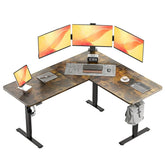Standing Desk Ergonomics: Avoid These Common Mistakes
Investing in a standing desk is a smart step toward better workplace health, but reaping its benefits depends entirely on how you use it. Poor ergonomics can turn a wellness tool into a source of discomfort or even injury. From incorrect height settings to ignoring body signals, many users unknowingly make mistakes that undermine the desk’s purpose. Understanding these pitfalls and how to avoid them ensures you get the most out of your standing desk while protecting your body.
One of the most prevalent errors is standing for too long, too soon. Eager to maximize health benefits, new users often overdo it, standing for hours without breaks. This can lead to muscle fatigue, foot pain, and even joint strain. The key is balance: ergonomists recommend a 1:1 ratio of sitting to standing for beginners, starting with 20 minutes of standing for every 40 minutes seated. As your body adapts over two to three weeks, you can gradually increase standing time, but even experienced users should never stand continuously for more than an hour. Listening to your body is crucial—tingling in the feet or lower back tightness are clear signals to switch positions.

Neglecting proper footwear and floor support is another critical mistake. Hard office floors or concrete surfaces offer no cushioning, placing excessive pressure on feet, ankles, and knees during standing sessions. Many users wear unsupportive shoes, like flats or dress shoes, which exacerbate discomfort. The solution is simple: invest in an anti-fatigue mat, which reduces pressure on joints by up to 50% according to studies from the National Institute for Occupational Safety and Health (NIOSH). Pair this with supportive footwear—shoes with cushioned soles or orthotic inserts—to further protect your feet. For those in formal workplaces, consider keeping a pair of supportive shoes at your desk specifically for standing.
Monitor placement is often overlooked but vital for preventing neck and eye strain. Whether sitting or standing, the top third of your screen should align with eye level to avoid tilting your head up or down. A common mistake is keeping the monitor too low, which forces you to hunch forward, straining the cervical spine—a leading cause of "tech neck." If your desk adjusts but your monitor doesn’t, use a monitor arm or riser to ensure proper alignment at any height. The distance from your eyes to the screen should also be 20 to 28 inches; anything closer can cause eye fatigue, while farther distances strain visibility.
Cluttered desk surfaces create unnecessary strain by forcing awkward reaching and twisting. When essential items like keyboards, mice, or phones are out of arm’s reach, you’re likely to lean or stretch repeatedly, straining the shoulders and lower back. The fix is to organize your workspace so that frequently used items are within a 16-inch radius—your "comfort zone" where you can reach without extending your arms fully. Use desk organizers, drawer dividers, or cable trays to keep surfaces clear, and position your keyboard directly in front of you with elbows at a 90-degree angle when typing. This neutral posture minimizes strain on the wrists and forearms, reducing the risk of carpal tunnel syndrome.

Incorrect desk height adjustment is a mistake that affects both sitting and standing positions. When standing, your elbows should form a 90-degree angle at the keyboard, with wrists flat and not bent upward. If the desk is too high, you’ll shrug your shoulders; too low, and you’ll lean forward. For sitting, thighs should be parallel to the floor, with feet flat on the ground (use a footrest if your feet don’t reach). Many users set the desk to a single "standing height" without adjusting it to their body, but ideal heights vary by person—someone 6 feet tall will need a higher setting than someone 5 feet tall. Take the time to experiment, and use programmable presets to save your perfect sitting and standing heights for quick access.
Ignoring movement is a final mistake that limits benefits. Standing in one place for long periods is nearly as bad as sitting, as it reduces blood flow and causes muscle stiffness. Even with an anti-fatigue mat, you should shift your weight, stretch your legs, or take short walks every 15 to 20 minutes. Simple movements like heel raises, leg swings, or shoulder rolls keep blood flowing and muscles engaged. Some users set reminders on their phones or use apps that alert them to move, ensuring they don’t get stuck in one position.
Ergonomics isn’t about perfection but awareness. By avoiding these common mistakes—balancing sitting and standing time, supporting your feet, positioning your monitor correctly, keeping a clear workspace, adjusting desk height properly, and staying mobile—you can transform your standing desk into a tool that enhances comfort, productivity, and long-term health. With a little attention to detail, your standing desk will support you in more ways than you ever imagined.
Ready to find the perfect standing desk for your workspace? Explore our curated collection of electric and manual standing desks at vvenace.com to discover ergonomic solutions that fit your needs and budget.



